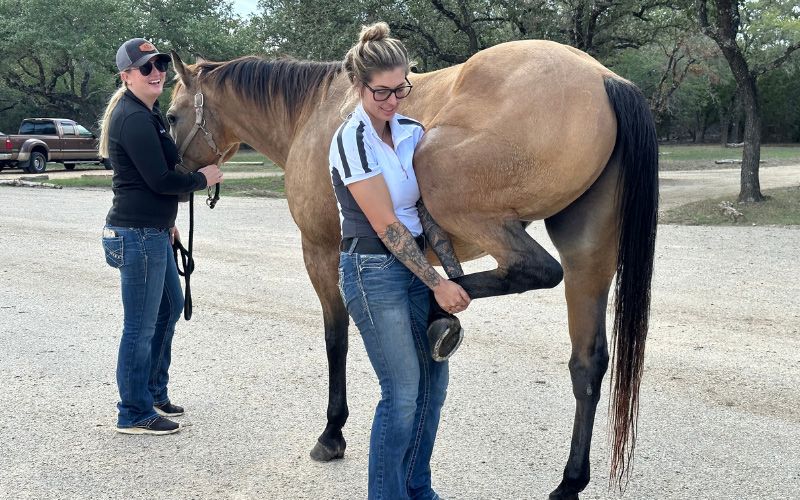Lameness Exams
Lameness Exams for Horses
Lameness is known as an inability to ambulate, or move, normally due to and injury, or dysfunction biomehcanics. Lameness can be a sign of various underlying issues or injuries that, if left untreated, may worsen, and result in long-term and/or career ending damage.
A lameness exam is a comprehensive assessment of a horse’s gait and overall condition, and it is essential for identifying the source of lameness and developing an effective treatment plan for equine athletes. The following discusses why horses need to be evaluated by a veterinarian when they are lame, what is involved in a lameness exam, and the importance of these exams in managing equine athletes:

Why Horses Need to be Evaluated When Lame
-
Early Diagnosis: Lameness can result from a wide range of causes, including musculoskeletal injuries, joint issues, hoof problems, or even systemic illnesses. Early evaluation allows for an accurate diagnosis, which is essential for effective treatment.
-
Prevent Further Injury: Ignoring lameness can lead to compensatory problems and secondary injuries. For example, a horse may shift its weight to alleviate pain, causing stress on other limbs or joints. Prompt evaluation may prevent secondary injuries.
-
Pain Management: Lameness often causes pain and discomfort for the horse. Addressing the issue promptly reduces the risk of inappropriate adaptation to pain, also know as windup. Windup can ultimately render our first line of defense, pain control, useless if left untreated.
What’s Involved in a Lameness Exam
A lameness exam is a systematic process designed to identify the source and severity of lameness in a horse. It typically includes the following components:
-
History: The veterinarian begins by taking a detailed history, including the horse’s work, exercise routine, recent changes, and any previous lameness issues. In this history, timing of onset, duration of issue, and other questions may be asked to better understand and characterize the issue.
-
Physical Examination: A thorough physical examination is conducted to assess the horse’s general health, conformation, and the presence of any obvious injuries or abnormalities.
-
Myofascial Exam: This aspect of the exam is hands-on evaluation of the horses tissues including fascia, muscles, tendons and ligaments. Changes in consistency, observation of applied pressure, and several other factors can lead your veterinarian to better understand the details of the presenting concerns.
-
Gait Analysis: The horse is evaluated at various gaits, such as trotting in straight lines and circles, to assess the lameness. This often involves observing the horse on different surfaces and in hand, on a lunge line, or under saddle.
-
Flexion Tests: These tests involve flexing specific joints for a set period and then observing the horse’s gait after release. Flexion tests are commonly used in lameness exams as an aid to evaluate dysfunction in a horse’s body. Many factors can influence results as flexion tests including pressure applied, height of clinician and more – as a results, flexions are not proven to be diagnostic for only joint discomfort.
-
Hoof Testing: The veterinarian may perform hoof tests to check for sensitivity; an area that may be positive to hoof testers can indicate navicular syndrome, seedy toe, an abscess, and many more hoof-related disease.
-
Anesthetic Blocks: Also known as nerve blocks, anesthetic blocks are commonly used from the hoof, upwards to isolate the area of discomfort. Your veterinarian may apply a nerve block and wait a period of time before asking the horse to move for evaluation of improvement.
-
Diagnostic Imaging: In some cases, diagnostic imaging techniques may be recommended like X-rays, ultrasound, or MRI to visualize and assess specific structures within the horse’s body.
The Three Points of Lameness Exams for Equine Athletes
Tailored Treatment: A proper lameness exam helps veterinarians isolate the source of the problem, enabling them to develop a tailored treatment plan. This may involve rest, medication, physical therapy, or even surgery, depending on the diagnosis.
Performance Optimization: For equine athletes, early evaluation and treatment of lameness and dysfunction are essential for optimizing performance. Identifying and addressing issues promptly can lead to quicker recovery and return to peak performance.
Long-Term Health: Undiagnosed lameness can lead to chronic issues that affect the horse’s long-term health and well-being. Lameness exams are key to preserving the overall health and soundness of equine athletes.
In summary, lameness exams are critical for identifying, diagnosing, and treating lameness in horses. For equine athletes, these exams are essential not only for their immediate recovery but also for their long-term health and performance. Proper care and early intervention can make a significant difference in the quality of life and success of these remarkable animals. At High Caliber Performance, we believe that horses in full work should be evaluated every 6 months, at a minimum, to ensure they are working at their top level.